





Big Pilot’s Watch Edition
“Le Petit Prince”. Ref. 5009: The little prince tells the pilot he will give him a friendly laugh from the countless stars in the night sky. The sight of this watch inspires similar sentiments, for every single detail is a joy to behold. The timepiece is not only an imposing 46 millimetres in diameter but also impresses with classic elegance that sets off the midnight blue dial to perfect advantage. Technical perfection, on the other hand, is guaranteed by the IWC-
manufactured 51111-calibre movement with its seven-day power reserve. Time enough to forget time and follow the dream-like journey of the little prince. IWC. ENGINEERED FOR MEN.
Mechanical movement, Pellaton automatic winding, IWC-manufactured 51111 calibre, 7-day power reserve when fully wound, Power reserve display, Date display, Central hacking seconds, Screw-in crown, Sapphire glass, convex, antireflective coating on both sides, Special back engraving, Water-resistant 6 bar, Diameter 46 mm, Calfskin strap by Santoni






Marc Dionne Photo, Courtesy Head-Line Mountain Holidays
Publisher/Editor Garth Eichel
Associate Publisher
Stephanie Cunningham
Art Director Brent Foote
Account Manager Garth Eichel
CONTRIBUTORS
Jennifer Boon
Ida Claire
Stephanie Cunningham
Sue Dunham
Garth Eichel
Bob Loblaw
Heath Moffatt
For information on display advertising opportunities, contact Garth Eichel at: garth@archipelagomedia.com
Published by
1248 Woodway Road
Victoria BC V9A 6Y6
Tel 250.380.3961
Fax 250.380.3962 www.archipelagomedia.com
Please send comments and suggestions to Garth Eichel, Publisher: garth @ archipelagomedia.com
In-Flight Review (IFR) is a quarterly magazine published by Archipelago Media Ltd. for Helijet International Inc. All published material is the copyright of Archipelago Media Ltd. No part of this publication, in whole or in part, may be reproduced without the written consent of the publisher. The written and photographic material published in In-Flight Review does not necessarily reflect the views of the air carrier or the publisher. Information and images produced in the magazine are believed to be accurate and truthful, but the publisher assumes no responsibility for errors.
Above: Head-Line Mountain Holidays leads guests on unforgettable glacier snowmobile tours near Whistler.

Above: New technology trends are reshaping the lives of British Columbians.
Cover: Doug Washer, President & CEO, HeadLine Mountain Holidays, gets some hang-time on a glacier near Whistler, B.C. Garth Eichel photo
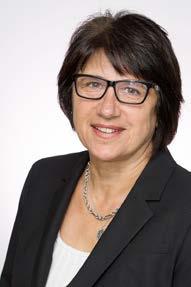
Linda Lupini, Executive Vice-President, BC Emergency Health Services
FLYING HELICOPTERS in British Columbia can be challenging — weather, geography and visibility are all issues, especially during certain times of the year. Flight delays for regular passengers can be frustrating, but for our provincial air ambulance service, they can mean the difference between life and death for a critically ill or injured patient.
However, BC Emergency Health Services are in the process of implementing exciting changes to our air ambulance service that will safely increase our opportunities to reach more patients at more times and in more locations.
Working with Helijet, night vision imaging system (NVIS) technology is being installed in three of our dedicated Sikorsky S76C+ air ambulance helicopters based in Vancouver and Prince Rupert. Helijet is one of our contracted service providers, and their
pilots fly air ambulance helicopters that get our paramedics quickly and safely to the patients needing their care. This new technology, specifically in the form of night vision goggles (NVG), will help Helijet’s pilots safely fly more often in hours of darkness or low ambient light. This in turn will enable our critical care paramedics to reach more patients needing emergency care and transport.
Night vision technology has been widely adopted by the military and, in recent years, civilian rotary-wing operations, including emergency medical services (EMS). The value of this technology to enhance service availability and improve pilot situational awareness has been proven through several decades of use in military, search and rescue, law enforcement and EMS operations worldwide.
Approximately 2,000 patients were flown by BCEHS’s air ambulance helicopters last year. It’s expected this night vision technology will mean at least 140 more patients each year can be transported via helicopter. The work BCEHS is doing with Helijet is part of a larger strategy which will see all BCEHS air ambulance helicopters in B.C. being similarly equipped with night vision technology as we move forward.
We expect our first in-service NVG equipped patient flights to begin in March. Enhancing our air ambulance program is a key part of BC Emergency Health Service’s plans to build a sustainable, worldclass emergency health care service that meets the needs of British Columbians. This technology is one more way we are ensuring increased safety and improved access to excellent patient care throughout the province.
BC Emergency Health Services (BCEHS) is responsible for the delivery and governance of pre-hospital emergency medical care and interfacility patient transfer services through the BC Ambulance Service and the BC Patient Transfer Network. BCEHS is supported by the Provincial Health Services Authority (PHSA). For more information, please visit www.bcehs.ca or follow us on Twitter @BC_EHS.


BY GARTH EICHEL
PHOTOS BY HEATH MOFFATT

LIKE MANY YOUNG MEN, Mike Garland had little idea what he wanted to do with his life after graduating from high school on the Isle of Sheppey, Kent, U.K., in 1984. Then one day his father showed him a Royal Navy recruiting ad in the local paper that boldly declared, “Fly Navy!”
The young Welshman thought that sounded pretty dashing and decided to enlist. He was successful in pilot selection and was soon sent to Britannia Royal Navy College, Dartmouth in 1986.
Garland remembers his first training flight in a DHC1 Chipmunk and how that set the hook:
“I fell in love with flying during the first hour. I
liked everything about it — the sights, sounds, and smells, but also the structure, the personal discipline, and sense of accomplishment. At age 21 it was exactly what I needed.”
Garland quickly progressed to helicopter training and upon earning his Royal Navy wings he was attached to the Fleet Air Arm where he spent the next 11 years flying the Westland Sea King in a variety of roles, from anti-submarine warfare and special operations, to search and rescue, among others. He enjoyed his time in the Navy, but after a family holiday in Alberta, he and his wife, Sue, decided they liked the Canadian way of life and decided to emigrate with their kids, Francesca and Jack. In May 1997 they made good on that: just three days after getting out of the Navy, Garland and his family were on their way to a new life in Calgary. He had the notion he might become a “real” Canadian helicopter pilot — flying heli-logging in summer and heli-skiing in winter. But things didn’t turn out as he had hoped.
“I was a bit naïve,” says Garland. “I imagined my dream job, but soon came face-to-face with the reality of hunting for a job.”
Aviation is an industry that does not reward those who sit at home waiting for the phone to ring, so Garland started networking with friends and contacts and eventually landed a job flying a B222 air ambulance helicopter in Kenora, ON.
Later, in 1999, he was hired by CHC as a training pilot on the Sikorsky S-61 — the civilian version of the Sea King he flew in the Royal Navy — and was sent to Thailand for the next three-and-a-half years. In the years that followed he flew CHC helicopters worldwide, mostly for oil and gas companies.
Globetrotting makes for an interesting career, but Canada often calls home its expat pilots and in December 2016 he returned to Calgary to fly the EC120 for the Calgary Police Service. That same month Brendan McCormick, then Helijet’s Chief Pilot, Rotary-Wing, invited him to join Helijet as a training and check captain. In this role, Garland delivers training to all company pilots, ensuring flight crew standards and practices meet and exceed Transport Canada’s requirements.







SIKORSKY S76A

BELL 206L3 LONGRANGER

SIKORSKY S76C+ (BC AMBULANCE SERVICE)

EUROCOPTER AS350 B2

LEARJET 31A
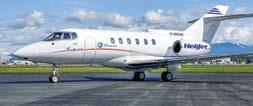
HAWKER 800A
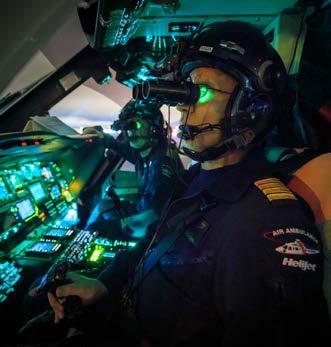
“I was hugely impressed by Helijet’s training department when I joined the company,” says Garland. “As a former IFR training and check pilot in the Royal Navy, I appreciate the company’s significant investments in safety and standardization of training elements. It’s exceptional.”
Garland’s background as a military and law enforcement pilot made him a natural choice to train Helijet’s pilots on the use of Night Vision Imaging System (NVIS) technology recently introduced into operations on the company’s S76C+ air ambulance helicopters providing service to BC Emergency Health Services. (See editorial, page 6.) Commonly referred to as “night vision goggles”, NVIS uses image enhancement technology to collect all available light, including infrared light, and amplifies it so the user can better see what’s going on during night operations.
The value of pilots being able to see in the dark cannot be understated.
“It’s massive,” says Garland. “NVIS is the single greatest safety enhancer for night operations. Helijet’s air ambulance crews will now be better able to identify obstacles and hazards, which will improve situational awareness and increase safety margins. Moreover, it will enable crews to access more scene calls and remote aerodromes at night.” He adds, “Helijet’s willingness to move in this direction is fantastic. I consider myself lucky to be involved.”





BY JENNIFER BOON

TED stands for Technology, Entertainment, Design — three broad subject areas that are collectively shaping our world. But a TED conference is broader still, showcasing important ideas from any discipline, and exploring how they all connect. The format is fast-paced: 50-plus talks over the course of a week, as well as morning and evening get-togethers where attendees and speakers from vastly different fields can cross-fertilize and draw inspiration from unlikely places. This is the magic of TED.
Attendance at TED is by application, and the attendees — scientists, CEOs, designers, intellectuals — are as extraordinary as the speakers. TED’s success is in bringing together up to 1,200 of the world’s most remarkable people across many fields, this time in Vancouver, April 10 to 14. The result? Unexpected connections. Extraordinary insights. Powerful inspiration. ted2018.ted.com
The Canadian Produce Marketing Association (CPMA) is a not-for-profit organization that represents companies that are active in the marketing of fresh fruits and fresh vegetables from farm gate to dinner plate. CPMA’s vision is to enable and lead the produce industry by enhancing the market and facilitating trade of fresh fruits and vegetables for its members. The CPMA convention and trade show, April 24 to 26, is the organization’s keystone event and Canada’s largest event dedicated to the fruit and vegetable industry. convention.cpma.ca
More than 3,000 brand and business leaders will convene June 4 to 7 to focus on how brands are updating their products and services to meet shifting consumer demands in an evolving economy. Participants will find unparalleled opportunities to connect with world-renowned thought-leaders driving sustainability-led change, and to collaborate on cuttingedge ideas that will help propel business initiatives forward. events.sustainablebrands.com/sb18vancouver
What does engagement look like in a new arts era? In an effort to attract and retain audiences and maintain relevancy to their communities, organizations and artists are experimenting with a wide range of innovative engagement programs and activities at a strategic level. Arts BC will hold its annual conference from May 10 to 12 at the beautiful Nikkei National Museum & Cultural Centre in Burnaby. This 2018 Arts BC Conference will include three days packed with learning and networking opportunities with arts and culture leaders from all over B.C. artsbc.org/conference

Our future is being shaped by technology that’s evolving faster than we ever imagined. From AI machine learning to virtual and augmented reality, technology is revolutionizing every part of our economy. In this wave of digital transformation and amidst the adoption of increasingly complex technologies, how can you break through and make smart, informed, data-driven decisions to succeed?
The #BCTECH Summit, May 14 to 16, is the largest technology conference in Western Canada, showcasing B.C.’s vibrant tech and innovation sectors. Hear from those pushing the boundaries of innovation and creating the jobs of the future. Join thousands of like-minded participants to explore how technology is driving cross-industry growth, and what companies need to do to emerge as global leaders. bctechsummit.ca



The CIM 2018 Convention, May 6 to 9, is a line-up of expertly led workshops, great networking opportunities, a complete student/young leaders program and a world-renowned trade show. This year’s convention will focus on thinking differently about the challenges, best practices and innovative insights in the mining sector. convention.cim.org

















BY JENNIFER BOON
The Association of Vancouver Island and Coastal Communities (AVICC) is the longest established area association under the umbrella of the Union of BC Municipalities (UBCM). The area association was established in 1950 and it now has a membership of 53 municipalities and regional districts that stretches from the North Coast Regional District down to the tip of Vancouver Island and includes Powell River, the Sunshine Coast and the Central Coast. The annual AGM and convention, this year to be held April 13 to 15, provides members with the opportunity to bring forward issues and concerns from their individual communities through resolutions and debates. avicc.ca/2018-convention-april-13-15
Since 1976, the Canadian Institute of Marine Engineering (CIMarE) has used Mari-Tech as an invaluable tool to provide a high-quality professional development experience for marine professionals involved in naval, governmental and commercial shipping and shipbuilding operations.
This premier national event, April 18 to 20, is the only one of its kind in Canada and is a great opportunity to learn about the latest developments, touch and feel the most modern technologies and network among highly talented peers. mt18.ca
The Canadian Automobile Association (CAA) is one of the largest consumer-based organizations in Canada and has been advocating on behalf of its members and the travelling public for over 100 years. The association helps provide peace of mind to over six million members through eight automobile clubs and over 100 offices located across the country. The annual conference, June 2 to 5, allows chapters to mix and mingle while sharing best practices.

Colleges and Institutes Canada (CICan) is the national voluntary membership organization representing publicly supported colleges, institutes, CEGEPs and polytechnics in Canada and internationally. This year’s conference, Working Together as One, April 29 to May 1, is designed around the theme of one community committed to excellence in education delivery, community building, innovation and leading change locally, nationally and globally. The hallmark of the conference is a thoughtfully curated program that will inspire, challenge and spark the desire for change. conference.collegesinstitutes.ca/2018

With the recent boom in artisan shops across the Pacific Northwest, the Cheese and Meat Festival aims to showcase both international and local cheese and meat in an experiential tasting format. Attendees will walk at leisure around Crystal Gardens, Saturday, May 12, enjoying bite-size samples of cheese and meat while pairing the bites with wine, beer and cider. cheeseandmeatfestival.com
The Canadian Astronomical Society was founded in 1971 and incorporated in 1983 as a society of professional astronomers. The society is devoted to the promotion and advancement of knowledge of the universe through research and education and membership is open to persons with a professional involvement with these goals in astronomy and the related sciences. CASCA Annual Meetings, this year held May 23 to 26, are open to all interested persons, whether belonging to the society or not, who register in attendance. casca.ca



in business and leadership start

CJ started a t-shirt design business as part of his Grade 10 personal project, a core part of the International Baccalaurete program. From design to outsourcing production, he directs all aspects of the operation. The school project is long since complete, but he continues to develop and market his growing clothing company.
JrK - Grade 12 IB World School in Nanaimo admissions@aspengroveschool.ca 250-390-2201

BY JENNIFER BOON
The Kid’s Conference, March 10, was created to help parents and children in Nanaimo discover and learn about resources available to all. Focused on bridging the gap between economic backgrounds and promoting a future for all children, the third annual conference will feature entertainment, speakers, vendors and more. Best of all, admission is free! thekidsconference.com

This event honours exceptional young business professionals under the age of 40 who are outstanding leaders in their chosen fields and are shaping their local community’s future. The winners and finalists will be recognized by their peers on Saturday, April 21, for their contributions to the Island’s regional economies and their community achievements. Entrepreneurs, executives, managers and professionals in the public, private and non-profit sectors who share demonstrated excellence in business, judgment, leadership and significant contributions to their communities will be acknowledged at this black-tie event. 20under40.ca/gala-info

This important conference, May 11 to 13, is intended to help health care professionals maintain their professional education. It is open to rural physicians, emergency physicians, family physicians, sub-specialists, nurses, nurse practitioners, midwives, paramedics, residents and students. Designed by rural physicians, this event offers accredited learning and provides practitioners with the opportunity to share knowledge, update and/or learn new skills and discuss cases within a larger group to facilitate learning and support. ubccpd.ca/ course/RHC2018

Nurse Practitioners (NPs) carry a protected title and are registered with the CRNBC as a distinct class of healthcare professionals. The goal of the conference is to provide members with opportunities for professional growth and practice, to offer interesting and educational topics and to provide an opportunity to network with other NPs around the province. This year’s conference, June 7 to 10, welcomes keynote speaker Dr. Melanie Rogers: Spiritually Competent Practice in Health Care and Global Perspectives of Advanced Nursing Practice Roles. bcnpa.org
This brand new conference will host five of the world’s top pioneers and brightest minds in the field of science and spirituality: Gregg Braden, Dr. Joe Dispenza, Dr. Bruce Lipton, Lynne McTaggart and Lee Carroll. This remarkable conference, June 14 to 19, includes full-day workshops, special twoday keynotes, presentations, panels and Q&As. Attendees will experience, practice and receive tools to implement in day-to-day life and spiritual path evolution, increasing awareness and expanding consciousness. shalohaproductions.com/ science-spirituality-conference

BY SUE DUNHAM

B.C.’s Office of the Superintendent of Real Estate introduces new rules for realtors
B.C.’S REAL ESTATE MARKET is a subject that never gets old. Stories abound of sellers making fortunes off the sale of modest properties, and for the past decade the trees seem to continue growing all the way to the sky. Real estate agents in the province have reaped significant commissions on the sale of properties over the years, which has (rightly or wrongly) fueled resentment among some homebuyers and -sellers — a perception made worse by the questionable practices of a few realtors who made headlines in Metro Vancouver in recent years. In an effort to protect home-buyers and -sellers, B.C.’s Office of the Superintendent of Real Estate introduced new rules for real estate agents that will take effect on June 15, 2018. The new rules were the result of recommendations made in a June 2016 report by an Independent Advisory Group that identified problems in B.C.’s real estate industry. In particular, the report warned that some real estate agents were failing to adequately disclose fees and commissions, and putting their own interests before clients. The report also warned that some agents were failing to abide by rules around reporting requirements to prevent money
laundering, while others were failing to disclose assignment of contracts — a practice sometimes referred to as “shadow flipping”.
Under the new rules, fines are being raised from $10,000 up to $250,000 for agents who are deemed to have engaged in unethical practices. Brokerages can be fined up to $500,000.
At first blush, the new measures seem wellintentioned, but there is much confusion surrounding interpretation and application of the new rules, and the law of unintended consequences has yet to kick in.
“Opinions are mixed,” says Wes McMillan, a real estate lawyer at Vancouver-based law firm Hakemi & Ridgedale LLP. “The new rules are in reaction to the perception that real estate agents are not properly explaining business transactions — specifically how they get paid — and therefore consumers are not making informed decisions.”
To rectify this, agents will now be required to provide greater transparency and documentation to the public in their transactions, which seems hard to argue with. The increase in paperwork will be onerous, but what dismays most agents, and some of their clients, is the end of dual agency — instances where a realtor represents both the buyer and the seller, thereby receiving the entire commission on any sale.
Under current interpretations by the Real Estate Council of B.C. — the body that interprets rules for realtors and applies discipline — a realtor can no longer represent both buyer and seller in the same trade except in extremely limited circumstances. But what is more, realtors may not be able to act for either party in certain situations. That’s because under the (shifting) interpretation of the new rules, listing agents will likely be unable to sell a home to a prospective buyer with whom they have had previous dealings. And if they possess confidential information about both the buyer and the seller they may have to refer both parties to other agents — a situation referred to as “double recusal”.
According to the BC Real Estate Association, only about five per cent of real estate transactions in the province involve dual agency, and not all situations necessarily compel double recusal. A large market like Vancouver is well served by legions of real estate agents, but smaller markets where inventory is limited could be more problematic for agents and their clients.

$1,249,999
Q White, bright, fully renovated kitchen includes all new stainless-steel appliances, quartz counters and deep pan drawers.
Q Spacious, newly decorated rec room on the garden level has sliding glass doors to maximize access to the backyard.
Q Refinished oak floors, fresh paint, new windows and 200-amp electrical service make this home move-in ready.
Q Stunning flat back yard features irrigation, a greenhouse, huge separate garage/workshop and veggie garden areas.
Q Minutes from the beach and close to parks, transportation, UVIC and all levels of schools. Updated family home just minutes from
I believe your home is an investment in your family and in your future. Allow me to assist you in making the most beneficial move. It’s April at RE/MAX all year long!


Let me help you plan for your financial future.

We work closely with you, determining not only your immediate goals but also your long-term plans. We believe that we can help protect your wealth and ensure it is passed on according to your wishes. Contact us to learn how we can plan for your financial future.
Grant
604 482 2461 grant.bell@td.com
“A very small number of agents go rogue each year, but it feels like we’re all being tarred with the same brush.”
– April Prinz
“The perception is that dual agency has the potential for conflict of interest,” says McMillan. “But this does not factor in pre-existing relationships between realtors and their clients.”
April Prinz, a Victoria-based real estate agent with RE/MAX Camosun, is not so troubled by the end of dual agency, as she is with how the new rules portray real estate agents. As she sees it, the new rules are a heavy-handed response to the actions of a few bad actors bringing the profession into disrepute.
“A very small number of agents go rogue each year, but it feels like we’re all being tarred with the same brush,” says Prinz. “The good side of the new rules is that they are designed to protect the public, but there is a lot of confusion around how the rules will be interpreted and applied, particularly with regard to confidentiality and agency.”
Specifically, Prinz worries situations may arise where she will no longer be able to work with clients she has previously represented, either as a listing or buying agent. Even a conversation with a potential buyer could result in an “implied agency”, which would violate the new dual agency regulations.
“People work hard to find a real estate agent they can trust, and they may stay with that person for years, purchasing and selling multiple properties. Buying or selling a home is a stressful event and people go through a lot with their agent, leaning on them for support, knowledge and professionalism. A relationship of trust develops. But the new rules may actually put the public at a disadvantage because they may force people to dismiss the agent they know and work with someone unfamiliar.”
Whatever the case may be, there is considerable uncertainty surrounding how the new rules will be implemented and enforced by the Real Estate Council of B.C. As such, agents across the province are scrambling to attend courses and seminars to get a handle on the changes. Certainly, the risk of a $250,000 fine focusses the mind.


BY STEPHANIE CUNNINGHAM
Suzanne Gatrell, President & CEO, Kingsbridge Management, on the challenges and satisfaction of running her own business.

Suzanne
Gatrell, President & CEO, Kingsbridge Management and Kingsbridge Management Group
U.K.
VICTORIA-BASED BUSINESSWOMAN Suzanne Gatrell knows what it takes to make it in the hotel industry. With more than three decades of tourism experience behind her, including nine years as the general manager of the Oswego Hotel, Gatrell took a deeper dive into the industry three years ago by starting her own international full-service management company, Kingsbridge Management.
Helijet’s In-Flight Review (IFR) magazine recently spoke to Gatrell about what it was like to start her own boutique hotel-management company, and buy her first hotel.
IFR: You’ve worked up through the ranks of the hotel industry. How has your career path led you to where you are today?
SUZANNE GATRELL: My whole passion is in this industry. I was so young when I started! Growing up in a small town called Kingsbridge, which is located in Devon, a county in the south of England, I started working in my family’s hotels and
restaurants at 14. After that, I worked my way up, training in four- and five-star hotels, so I’ve developed a full understanding of what my team does and feels. That really helped me as I moved into senior leadership roles. At every stage of my career I’ve always felt I was ready for the next step.
What made you decide to switch from being an employee to starting your own hotel-management company three years ago? Why take the risk?
Why do any of us do our own business? Because we’re looking for more.
Deep down, I wanted to be able to make bigger decisions and choices, and I think that’s what fueled me. I remember coming to a crossroads where I could carry on, or I could take a risk – and buying a hotel is huge a risk. But that doesn’t scare me; it just makes me even more diligent.
Kingsbridge Management specializes in operating small, boutique hotels. What do you look for when you’re considering purchasing, or managing, a hotel?
I’m looking for independent hotels with less than 100 rooms because that is where I have focused a lot of my career. Independent hotels allow the autonomy to grow the property to what you and the owners want it to be. It’s not mandated through a big corporate structure; it can be very real and authentic. In the U.K. there is an abundance of independent hotels that range from 25 to 60 rooms, and that is what I love.
How is your role different now that you are the owner of Kingsbridge Management, as well as GM of the Oswego?
The first year I still worked very much as GM, but I quickly learned I was working in my company, not building my company. I knew I had to delegate, so I hired one of my longtime managers to be operations manager at the Oswego, taking care of my day-to-day. I’m still very involved in the hotel’s operations, but hiring someone I can rely on has given me a chance to really grow Kingsbridge, focusing on where I want the business to go, and what steps are needed to get me there.
When you hire employees, what is the number one thing you are looking for?
Hands down, it’s being authentic, being genuine, being a part of the company and representing the company. We can teach the skill set, but it’s believing in, and being part of, the vision of the company that’s most important.
As an advocate for women, what do you see as the future for women in the hotel industry?
When I learned women at the CEO level account for only about two per cent, that hit me hard. I frequently go to tourism-related conferences and speak openly about getting an equal platform for women, and getting our voices heard. It’s going to take determination, but more and more I have women come to me saying, “You have inspired me to do it!”
You’ve been in the hotel industry for 30 years. What’s changed most in that time?
Higher guest expectations. Expectations have always been there, but I think it’s more prevalent now than ever before. Guests don’t want to just stay in a hotel; they want to have an experience. People are much more meaningful with how they spend their hard-earned money than they were 10 years ago. They aren’t going to hand it over for any old hotel room. They want to get value, and rightly so.
Giving back to employees is certainly important, but what about giving back to community?
It’s huge for me to give back to whichever community I’m in. Whether I have a hotel in England or in Victoria, the community is what supports that property, and they are part of it. Whether it’s the team you employ, or the local people who come and visit, it’s so important for a hotel to listen to the local community and say “thank you”.
What do you like most about running your own business?
I like the autonomy as the owner to make final decisions collaboratively with my team. But there are also hard and challenging things. I wouldn’t say they’re bad – they’re just challenging. As a business owner you learn from the down times as well as the good times. The things I like least are also what I love most because they make me better at what I do. I can’t imagine doing anything else.
kingsbridgemanagement.com


3030A NANAIMO ST VICTORIA, BC V8T 4Z1 250 661 5018



MILESTONES DESERVE TO BE CELEBRATED.
So when my 50th birthday rolled around this spring I decided to splash out on a daylong heli-sledding tour with Whistlerbased Head-Line Mountain Holidays.
The morning of my adventure starts at the Whistler Heliport where I’m greeted by Doug Washer, President and CEO, and Trevor Broemer, one of Head-Line Mountain Holidays’ most experienced snowmobile guides. The pair inform me and three other guests that there is a record amount of snow on the glacier today and snowmobiling conditions are excellent. The news generates a collective feeling of excitement and anticipation; everyone is anxious to get airborne and on our way to the glacier!
To that end, Washer and Broemer help the group gear up, fitting us with helmets, goggles, boots and gloves, as well as backpacks and shovels. I’m impressed to see the equipment is all top-of-the-line, and in excellent condition.

After a quick safety briefing, Washer and Broemer escort the four of us out to a waiting EC130 helicopter. Once we’re buckled in, the pilot lights the helicopter’s engine and the turbine howls to life. Sitting in the front seat, I watch as the pilot goes through a series of checks before lifting the aircraft up into a shallow hover. We pause momentarily before lurching up and forward, climbing westward out of the Whistler Valley above steep forested slopes.
After about 10 minutes of scenic flying the landscape below begins transforming as treecovered hillsides give way to rocky mountaintops. Our pilot points ahead to the glacier we are destined for. It is a majestic sight: soon we are flying above a remote world of rock, ice and snow, far removed from the rest of the world. The pilot descends towards a small glacier hut atop the ice field, wheeling in a downward arc that offers everyone on board a panoramic view of a landscape rippled by the powerful forces of nature.

Approaching the surface of the ice cap, the downwash of the rotor blades kicks up a whirlwind of snow as the helicopter touches down in a spot pre-marked by Head-Line’s guides. Washer and Broemer exit the helicopter and then signal everyone in our group to disembark, cautioning us to keep our heads well down, clear of the turning rotor blades. We rally at the nearby shed and Washer signals to the pilots that it’s okay to depart. With that the EC130 lifts off, showering us in snow, wind and noise. A minute later the aircraft is out of sight, and the din of rotor blades gives way to stark silence. There is not a breath of wind on the glacier, and time seems to be standing still. Our group is suddenly all alone, a long way from civilization.
But not for long. Washer and Broemer go into the glacier shed and moments later the

snarl of snowmobile engines coming to life reminds us why we’re here. Each of us is assigned our own Ski-Doo, and I’m surprised at how large each is — especially the long track extending behind each snowmobile.
“A long track is better for deep snow and hill climbing,” explains Washer. “These snowmobiles are specially designed for backcountry sledding.”
They’re also easier to handle than I expect. I’m a novice rider with limited experience and ability, but after a quick tutorial I’m soon carving s-turns back-n-forth. I feel competent, bordering on cool!
“Glacier snowmobiling is actually much easier than trail riding,” explains Washer. “Snow conditions are far better, and the wide-open spaces are suitable for riders of all abilities. You don’t need to be an expert.” He adds, “We use helicopters to transport guests up here where the best conditions are. The 20-kilometre forest trail most people ride to get here can be hard sledding at times, especially when it gets chewed up by lots of snowmobile traffic.”
Indeed, glacier snowmobiling is to trail sledding what heli-skiing is to chairlift skiing: one allows exclusive access to premium conditions while the other involves crowds, line-ups, and steadily deteriorating snow conditions. There is no contest between the two.
Because we flew in at first light there are no other riders on the glacier yet. We have this

winter wonderland entirely to ourselves and I can’t wait to explore all the glacier has to offer. To that end, our group sets off with Broemer in the lead and Washer bringing up the rear. We pick up speed across a flat section of glacier and with each passing minute my confidence rises, as does the speedometer. I am at first comfortable doing just over 50 kmph, but after 10 minutes I’m doing over 60 kmph. After 20 minutes I’ve reached the upper end of my comfort zone at around 75 kmph.
Broemer coaches me on additional handling techniques, showing me how to turn in deep snow by standing up and forward on one side of the sled for maximum control. It feels weird switching side-to-side on the sled through turns, but after a few minutes of practice I’m carving through knee-high powder with a measure of confidence. I feel pretty awesome for 50!
The long-track glacier snowmobiles really come into their own going up-hill. It seems counterintuitive to accelerate going uphill, but this keeps the snowmobile from bogging down



in deep snow and on my first attempt up a steep gradient I’m amazed at how the sled soars skyward like a homesick angel.
The fast upslope ride is a tad nerve-wracking at first, but the reward at the top is a panoramic view of the Coast Mountains that surpasses any mountainscape I’ve seen before. In every direction are jagged mountaintops fencing in rolling glacier fields. The beauty of it is both fantastic and haunting.
Our group rests and enjoys the vista for a while before pressing on. Abilities vary in our group from beginner to advanced, but each person’s confidence and capability increases with each new hill climb and downslope. By mid-morning we are all handling our Ski-Doos better than we thought possible.





Still, it takes strength and energy to handle a big glacier snowmobile, and after a few hours of sledding I’m starting to feel my age a bit. Fortunately, so is the rest of our middleage group, and so we thread our way back to the glacier hut where Head-Line Mountain Holidays’ own backcountry chef, Danny
































































































O’Donoghue, has laid out a fantastic shish kebab barbecue, complete with chunks of grilled tenderloin, marinated chicken, giant prawns and large scallops, accompanied by baked nugget potatoes, fresh buns, and a selection of colourful salads.
Danny is the most popular guy on the glacier right now, but he has one more surprise in store. Before we departed on our snowmobiles this morning he slipped pork ribs wrapped in tinfoil inside the engine compartment of each sled where they slow-cooked atop the engine manifold. Peeling back the tinfoil on my packet, I discover a mouth-watering side of ribs cooked to perfection.
Backcountry cuisine just doesn’t get any cooler.
For the next hour our group indulges in exceptional food and cheerful laughter, and there is a feeling of comradery that comes from sharing in an extraordinary experience.
After a delightful lunch I’m not quite ready to get back on my sled with a full belly, so I take a bit of time to wander about and explore the

Cooked to perfection: Head-Line Mountain Holidays’ snowmobile guides Doug Washer (left) and Trevor Broemer dig into barbecued ribs slow-cooked in the engine compartment of their snowmobiles.
surrounding scenery. I take several photos on my smart phone to record the moment and, to my surprise, discover we’re up high enough to get cell reception. I’m not an avid user of social media, but this is definitely one experience I figure warrants a post. I update my status accordingly, letting family and friends know I’m 50 years old today and on top of the world.



Bear Mountain is the premier golf experience in Canada with two Nicklaus Design golf courses.
Book your Stay & Play Package today. Rates starting from $155 per person! Choose


BY STEPHANIE CUNNINGHAM
THERE IS NO SHORTAGE of success stories when it comes to the tech sector in B.C.
Situated at the cross-roads between Asia and the Cascadia Corridor, B.C. is ideally situated to attract and retain some of the best research and technical talent in the world. In fact, B.C.’s technology and innovation industries have seen records broken across the board in employment, salaries, revenue and GDP – ingredients that all point to a bright future for a province that is quickly becoming a global centre for innovation.
From mind-bending developments in augmented and mixed reality, to world-renowned genome research, an exciting blend of innovation, creativity, collaboration and entrepreneurial spirit has laid the foundation for a variety of made-in-B.C. technological advancements.
The latest government stats released in mid-November 2017 reveal the tech sector in this province boasts more than 10,200 businesses employing over 106,000 people. To put those numbers in perspective, that’s approximately five per cent of B.C.’s workforce – more than the forestry, oil and gas and mining sectors combined.
And those employment stats don’t just represent jobs; they represent well-paying careers. Tech employees in this province earn an average weekly salary just short of $1,700 per week, which is almost 85 per cent higher than the average B.C. wage. What’s more, B.C.’s tech companies generated close to $29 billion in annual revenue in 2016 and contributed almost $15 billion to the
province’s overall economic output – a full seven per cent of the provincial GDP.
One might expect Vancouver to be the centre of all things tech in the West, but not so fast. While the cobblestone streets of Vancouver’s Gastown and Yaletown see their share of techie traffic each day, other areas are magnets for tech talent as well. Victoria, better known as “Tectoria” to those in the know, boasts more than 900 tech companies, $3.5 billion in annual revenue and 15,000 workers. And in the Thompson-Okanagan, more than 800 tech businesses and a workforce 7,600 strong has earned Kelowna the nickname “Silicon Vineyard”. While the tech sector has gained a foothold in B.C., there is certainly room to grow. South of the border, big-league players such as Amazon, Microsoft and Expedia have made Washington State a tech powerhouse with the sector contributing over $59 billion to the economy – a number that currently far out-paces B.C.’s figures.
But B.C. may well be hot on Washington’s heels. In February, the B.C.-born Digital Technology Supercluster consortium was awarded a significant federal-funding infusion meant to supercharge Canada’s innovation ecosystem. With a focus on advancing projects guided by industry needs, the funding is projected to create an estimated 50,000 jobs in B.C. and inject $15 billion in GDP over the next 10 years. The province has also appointed its first innovation commissioner, Dr. Alan Winter, to champion further investment as well as partnership opportunities with our neighbours to the south through the Cascadia Innovation Corridor.
There are lots of selling points to make the case
“I believe improving trade relations with the world can have a positive impact for everyone in BC.”
Espinosa-Malpica
Hometown: Vancouver, BC BA, Economics and Political Science
For a better BC.

ubc.ca/forabetterbc
for investing in tech in B.C., but a quick snapshot of five up-and-coming tech trends that are gaining traction helps illustrate how technology will change the way British Columbians live, work and play.
5G is the next giant leap for the internet and the race is on around the globe to deploy the world’s fastest and most reliable wireless tech yet.
Since 2015, Telus has partnered with global heavy-weight Huawei to conduct trials for this next-generation connectivity at its “5G Living Lab” in Vancouver.
Clocking in up to 200 times faster than LTE networks, sluggish connections will be a long-gone memory with this new tech and increased speed is only the beginning. With unprecedented stability and lower latency, 5G connectivity could finally push driverless cars, drones and a myriad of yetto-be-imagined applications into the mainstream.
The Internet of Things, IoT for short, is the built-in ability for everyday items to connect via the internet to collect and exchange data. In day-to-day life
it’s the fitness tracker on your wrist that shares your running time on social media. It’s the thermostat that learns your schedule and adapts the heating in your home as the seasons change. It’s the car sensor that alerts your insurance company when your car has been in an accident.
In the business realm, IoT creates efficiencies and increased productivity across all kinds of industries. From machinery that can re-order its own materials when supplies are low, to real-time tracking of goods, tools and employees, IoT enables businesses to be highly responsive to demands and to quickly resolve issues when and where they arise.
Headquartered in Richmond, Sierra Wireless is developing IoT applications for everything from real-time patient monitoring, to container tracking on ships and tolls on bridges. To date, Sierra Wireless has shipped over 130 million devices to connect the IoT – and counting.
Combine IoT with information and communication technology (ICT) and you have the makings for a “smart city”. Worldwide, cities are building a future
Combining time-tested portfolio strategies with best-in-class estate planning for the protection of your family’s estate. Contact us today for a complimentary risk review.
Peter Schenk Portfolio Manager www.theschenkgroup.com





































where digital tools and data are used to monitor and manage civic resources and infrastructure to make communities more livable and governments more efficient and accessible.
Born out of necessity and spurred by economic savings, cities are implementing a variety of smart initiatives using sensors, cameras, apps and other real-time tech solutions to collect, analyze and use data. These digital tools help governments to monitor and control water quality, traffic congestion, waste collection, graffiti removal, street lighting, policing and too many other services to mention.
As part of its smart strategy, Vancouver has installed 550 free public Wi-Fi locations, 75 charging points for electric vehicles and 1,200 bikes in its public bike-sharing system. And those initiatives are just the beginning.
To help boost the adoption of smart technologies, the federal government has launched a Smart Cities Challenge to encourage communities of all sizes to submit proposals for smart solutions that address their most pressing problems. Watch for winning solutions to be announced in 2019 and for Canadian municipalities to get that much smarter.
As many of us still try to wrap our heads around the concept of virtual reality, the tech industry has forged ahead with augmented and mixed realities. So what’s the difference between the three?
While virtual reality places the user in the middle of a virtual world, augmented reality overlays virtual elements on the real world. If you’ve ever played Pokémon Go to navigate around a digital map in pursuit of animated characters, you’ve already dipped your toe into the world of augmented reality.
In mixed reality users navigate through both the real and virtual environments at the same time. It allows users to place a virtual sofa in their own living room to see if it suits the décor before ordering it from the store. Or for workers wearing smart goggles to virtually overlay assembly instructions right on the equipment they are repairing. And, in educational settings, VR/AR/MR can help students learn about everything from geography to surgery. With spillover talent from the film special effects and gaming industries, B.C. is quickly demonstrating a depth of expertise in the areas of VR/AR/MR. Companies such as Finger Food, Cognitive 3D, and Llama Zoo are just a few of the homegrown



As a third-generation, family-owned business, our core values have not changed — we have always believed that we must earn the right to our clients’ business with every project we produce.
Western Canada since 1928

success stories that span the realms of gaming, education, health and business applications.
Developments in technology become especially personal when it comes to healthcare. In fact, it gets down to our very DNA.
By the time the Human Genome Project wrapped up in 2003 after 13 years of research and $3 billion of investment, it had successfully mapped out all human genomes. Since that time, researchers have started to use that data to pinpoint drugs and medical therapies that can target specific diseased cells – a method of treatment called precision health.
Genome BC, a non-profit organization that invests in the research and commercialization of life sciences in B.C., is helping to advance the study of precision health by funding research projects that aim to address the root causes of diseases, not just the symptoms. This research is so exact, initiatives can even be targeted to address health challenges specific to certain populations such as Indigenous children with genetic diseases, so that diagnostic outcomes can be improved and inequalities in access to advanced health care can be reduced. From asthma to childhood brain cancer, the opportunities to improve health outcomes using genomic research are endless.
But genomic research is not only used to power new and better medical treatments for people, it can also be used to find solutions to some of the most pressing challenges facing B.C.’s resource sectors. Take forestry, for example.
Spotted leaves, cankered stems and bare branches all point to trees being attacked by pathogens or insects. Some of those may be alien forest enemies, which pose a significant threat to Canadian forests, tree farms and nurseries. And while traditional techniques often take weeks to identify pathogens, Dr. Richard Hamelin from UBC and Laval University has developed genomic tools that can identify pathogens even before the symptoms appear thus preventing infectious saplings from entering forests and nurseries. It’s a tool that is already being used by the Canadian Food Inspection Agency; the BC Ministry of Forests, Land and Natural Resources Operations; phytoremediation companies such as Passive Remediation Systems; cities such as Victoria and West Vancouver and even Butchart Gardens.

Genome BC’s Industry Innovation Program (I²) provides commercialization support for companies developing innovative life science technology-based products, processes or services in British Columbia.
We help early stage companies move from seed to Series A or other significant financing events by offering repayable growth capital on favourable terms at a critical stage of business development.
•Funding allocation: $100K to $1M per company
•Matching funds required (1:1)
•Non-dilutive, repayable funding and success oriented service fees
•Access to Genome BC’s network and expertise
BY BOB LOBLAW

SLEEP DEPRIVATION AND INSOMNIA are widespread issues in developed countries, where people can stay connected to family, friends and work at any time of day or night. While innovative treatments offer relief for some insomnia sufferers, sleep science has increasingly revealed that sleep is a complex process, involving many stages, cycles and types of brainwave activity. Some people don’t understand this because, for them, sleep is simple. For many others, however, falling asleep and staying asleep throughout the night can be the most challenging task they’ll undertake in a 24-hour period.
That’s because sleep is a conundrum that seldom responds to the straightforward methods we use to solve other work and life problems. In fact, the direct approach, which involves making an effort and applying force to the issue at hand, almost always causes stress leading to increased frustration that ends in an insomniac’s nightmare of sleeplessness.
The following all-natural solutions — “natural” here means designed to work with your body’s cycles and automatic responses — can be implemented with minimal disruption to schedules and daily life.
One of the best things you can do to help eliminate insomnia is reinforce your body’s natural sleep-wake cycle. Going to bed and waking at the same time every day will help establish your circadian rhythm to the point where less and less effort is required over time. Consistency counts, though, so resist the urge to sleep in on weekends and holidays. If necessary, you can make up for lost sleep with a brief mid-day nap, but avoid napping longer than 30 minutes as anything more than this can make falling asleep at night that much harder, starting a cycle of insomnia all its own.
Establishing a relaxing bedtime routine will also help condition you for sleep. To that end, try things like taking a hot bath, listening to calming music, or reading a light and entertaining book or magazine that won’t overstimulate.
One bedtime habit to avoid is watching television in the bedroom. Some people may think TV helps them unwind, but late-night news and dramas often have stimulating, if not disturbing, content and
images. And if you fall asleep with the TV on, the constant noise and light from the screen will disturb your sleep throughout the night.
The sleep of the righteous is an enviable thing, but life has a habit of getting in the way for many of us. Work, family and finances keep us all awake at one time or another, so getting those and other stressors in check is key to good sleep. While you can’t easily eliminate stress and anxiety, there are a variety of relaxation techniques that can help mitigate what’s on your mind, including such things as deep-breathing exercises, visualization, meditation and journaling. Certainly, if you get a good night’s sleep you’ll be better able to face life’s stressors in the cold light of day.
Healthy choices before bed will markedly improve your quality of sleep. In keeping with that, avoid big late-evening meals, and allow at least two hours between eating and sleeping. Likewise, lay off spicy foods that can cause heartburn during the night. Alcohol intake is another factor to consider. Some people believe a nightcap before bed helps
them relax and get to sleep, but booze is more than likely to disrupt and degrade the quality of a person’s slumber.
Caffeine after noon is another no-no. That’s because it can cause sleep disturbances for 10 hours or more after being consumed. As well, avoid drinking too much liquid before bed as this can result in frequent trips to the bathroom during the night.
And what sermon on healthy living would be complete without the admonishment to quit smoking? That’s because nicotine is a stimulant that inhibits and disrupts sleep. In fact, heavy smokers can actually experience withdrawal symptoms while they sleep.
Insomniacs need to turn their beds into a shrine for two things — sex and sleep. When not employed for carnal purposes, the bedroom should be a sanctuary for sleep. To that end, eliminate noise and light as much as possible.
Everyone is different, but most of us sleep better when there is an absence of noise. If you can’t eliminate external noises — dogs, traffic, etc. — try blocking it with earplugs or white noise, such as a fan or special sound device.


With their expertise in Human Resources and knowledge of employment standards, Chemistry updated and added to our policies and procedures to ensure that we were not only compliant, but that we also had ‘best practice’ policies to be the best employer we could be.
Carol Simpson Chief Executive Officer of Focus Professional Services Inc.
Contact us today.
T 250.382.3303 E info@chemistryconsulting.ca chemistryconsulting.ca








Eliminating light is key, too. According to Harvard Medical School’s Healthy Sleep resource, artificial light (a relatively new development in human history) can signal the brain to remain alert, thereby delaying the onset of sleep. In addition to cueing the brain to stay awake or wind down, light and darkness influence the circadian system that regulates sleep/wake cycles over longer periods of time. This means that the habitual timing of your exposure to light and darkness programs your body to sleep at certain times. If you’ve ever tried to nod off when your brain has other plans, you understand how powerful these cycles can be. Working with them, rather than against them, greatly increases your chances of success in managing a chronic sleep problem.
Some sleep-deprived sufferers are so sensitive to light cues that illumination from street lights or even a full moon on a clear night will disrupt the natural processes that enable them to fall asleep. If so, consider covering the windows in your bedroom at bedtime with heavy construction paper to eliminate light leaking in.
Similarly, if you struggle with sleep maintenance insomnia, the early dawn of the summer months will rouse you long before your alarm. If papering your
windows makes you worry the neighbours will think something illicit is going on in your bedroom, consider wearing an eye-shade or installing blackout blinds made of material designed to block ultraviolet rays.
And if there is one thing that is sure to ruin a good night’s sleep it is the personal electronic device you are most attached to. Whether it’s a smart phone, a tablet or a laptop, the combination of a direct light source, together with a constant communication portal to friends, family and work is certain to inhibit restful sleep.
Most people sleep best in a room slightly cooler than standard room temperature. A well-ventilated room somewhere around 18°C is ideal.
A comfortable bed is a good investment, too. It should be big enough that you can turn and stretch, even with a companion sharing it. Good pillows that provide just the right support are also worth the investment.
If you’ve done everything you can to make your bedroom conducive to slumber, and you still can’t fall sleep after 20 minutes of lying still, then consider changing locations. This sensible practice helps

prevent creating negative associations between the sleep environment and the frustration of sleeplessness. Changing your sleep environment takes this reasoning one step further, by redirecting the intention to sleep in a place that’s associated with an activity other than sleep. People struggling with sleep disorders often find the new location’s sounds and smells help to make a clean break with established patterns and reactions. In other words, by changing the environment, you alleviate frustration and remove the sense of urgency to fall asleep. This strategy works precisely because it disrupts patterns and overturns accepted notions about where and how you should sleep. And if you’re concerned about making your living room sofa a permanent bed, keep in mind that you’ll probably wake up naturally in about 90 minutes, stagger back to your real bed and sleep for the rest of the night.
Researchers have found encouraging results in light therapy trials with sleep-disorder sufferers. Apparently, getting sunlight in the morning resets your body clock, predisposing you to rise at the same time the next day. If you work in an office or start work before sunrise, use your morning break to get

some daylight. Remember, habitual exposure to darkness when you want to sleep, and light when you need to wake up, programs your body to maintain the same schedule over longer periods of time.
And in the dark, rainy days of winter when natural sunlight is scarce, consider purchasing a good quality Seasonal Affective Disorder (SAD) light that you can expose yourself to in the morning and evening, around the same time the sun is normally rising and setting. This will have a similar effect on the brain as natural sunlight and can also help improve your overall mood after a few weeks of use.
Sleep medications are a slippery slope. They are not meant to be taken regularly, but users desperate for sleep can easily become dependent on them. Worse still, when mixed with alcohol, sleeping pills can be deadly.
If you’ve tried everything, but still struggle with sleep and sleeping medications, contact a physician as you may have a sleep disorder that warrants professional treatment.
Whatever the case may be, insomnia is a highly treatable condition that can be naturally overcome by changing daily patterns and behaviours.
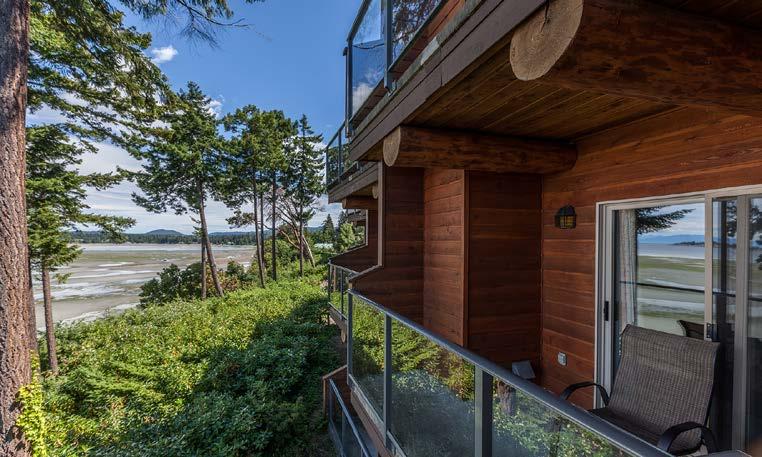



Fine clothing, accessories, custom tailoring and superior service have been in our family since 1917.
We welcome you to our store in Victoria to discover the colors, texture and quality of our unique merchandise.
Fine Clothing, Sportswear & Accessories Since 1919
Fine Clothing, Sportswear & Accessories
#110-735 Yates street st. andrews square 250.384.8087 kstraith@shaw.ca
Phone: (250) 384-8087 Facsimile: (250) 595-6674 eMail: kstraith@shaw.ca
St. Andrews Square, 110-735 Yates Street, Victoria, British Columbia V8W 1L6



The folks at the Grotto Spa at Tigh-Na-Mara in Parksville have reason to celebrate. Not only is the spa celebrating its 15th anniversary this year, it was recently named the number one spa in Western Canada and number one “Ocean Spa Experience in North America” by Spas of America – high praise indeed from the largest spa travel directory in the continent.
“Our philosophy from the day we opened back in 2003 has remained the same: we believe in offering relaxing guest experiences that go beyond the expected,” says Grotto Spa director, Paulina Alexander.
The Grotto Spa offers 20,000-square-feet of spa bliss in a tranquil West Coast setting. Spa guests are encouraged to enjoy a soothing dip in the mineral pool, relax in the warmth of a spa treatment, rest fireside with tea in the relaxation lounge and enjoy endless tapas while overlooking the surrounding forest. grottospa.com
A seemingly endless array of anti-aging skin-care treatments can make it challenging for both men and women to select just the right products or procedures to achieve desired results. Aesthetic services such as lasers, Botox treatments, fillers and surgery require thorough education, but unbiased advice can be hard to find, and medi-spas can have limited time and resources available to devote to individual consultations.
That’s where Polished and Professional comes in.
Based in Victoria, owner Rachel Varga, an expert clinician in Cosmetic Dermatology, offers personal educational consultations via Skype or FaceTime to clients around the globe. From the comfort of home, clients can discuss options, ask questions and move forward with confidence knowing they have the information they need to pursue safe, conservative and natural looking results. polishedandprofessional.ca


www.BudgetBC.com



No nip and tuck, it’s a total makeover for the heart of the house at Cedars Restaurant & Lounge at Tigh-Na-Mara Seaside Resort & Spa in Parksville, B.C. The restaurant’s newly renovated layout features a huge new stone oven that offers guests a front-row seat as chefs create contemporary rustic offerings such as artisan pizzas, breads, seafood skillets and more.
“We are always making improvements to enhance guest experiences at the resort, and it is with great excitement that we will offer a whole new dining experience at Cedars Restaurant & Lounge,” says Bryan Stokes, director of food and beverage.
Along with the revamped layout, Cedars has also added a take-out menu to its offerings giving guests and locals alike the option to place orders for pick-up. tigh-na-mara.com

Helijet_Spring2018.pdf 1 18-02-09 12:02 PM


Sometimes inspiration is a many-layered thing. That which stimulates one creative endeavour can inspire something completely different, which in turn spurs the imagination to create yet another work of art. Such is the journey of Lugaro’s one-of-a-kind sapphire and diamond pendant (pictured above).

Want to know what’s really happening under the hood of your car? You can take it to a mechanic to have it road tested – or you can get it “dyno”-tested.
Inspired by the architecture of UBC’s Museum of Anthropology, an award-winning building designed by renowned Canadian architect Arthur Erickson and based on Northwest Coast First Nations structures, this pendant features a spectacular 5.24-carat oval-cut blue sapphire as its centrepiece. Surrounded by 3.08 CTW GIA Certified baguette-cut diamonds in an 18-carat white-gold halo, the pendant’s modern design is truly West Coast-inspired and sure to be an outstanding addition to any jewelry collection. lugaro.com

With the only Superflow Autodyn 30 All-Wheel Drive dynamometer on Vancouver Island, Paradigm Autoworks in Victoria has taken the guess work out of car performance assessment using this state-ofthe-art diagnostic tool. Capable of safely measuring up to 2000 hp and 185 mph, it can put almost any car to the test – and come out a winner. paradigmautoworks.com

BY IDA CLAIRE
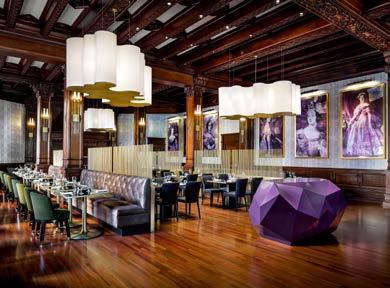


BUSINESS PEOPLE ARE BUSY by definition. I’m no exception. Sometimes there just aren’t enough hours in the day. Yet I’ve learned a few time-management tricks to make the most of every available minute. Chief among these are business lunches where I can make a personal impression on clients, solidify relationships, all the while enjoying a delightful meal.
Key to success is finding the right restaurant. A greasy spoon will reflect poorly on my judgment, and bad food or service is sure to leave a negative impression on clients. That’s why my favourite go-to business lunch spot is Q at the Empress in Victoria’s Fairmont Empress hotel.
Newly renovated in 2017, Q at the Empress provides everything I need for a successful business lunch. In particular, the new “Q in 60” set menu is tailored specifically for business people who need to make the most of their noon hour and get on with their day.
Available Monday through Friday, from 11:30 a.m. to 2:30 p.m., Q in 60 guarantees a quality dining experience in 60 minutes or less for the reasonable price of $32 per person. That includes a starter, main course, and a dessert, all delivered by staff who appreciate the importance of timely and professional service.
My most recent business lunch was an important one. I was meeting with the new director of sales at a company I’ve long worked with. As any business person knows, change in management can be either a good thing or bad thing, depending on the “new direction” an individual intends to take the organization. As such, I wanted to get off on the right foot and so I suggested we meet on a Wednesday for a Q in 60.
The Fairmont Empress is an iconic local institution, so choosing this venue helped set a respectful tone for the meeting. In particular, I like how the atmospheric décor of the newly renovated restaurant combines old-world charm with sophisticated and contemporary elements — simultaneously signalling tradition and forward thinking.
I was careful to reserve ahead and ask for a private table where my guests and I won’t be disturbed, but truth be told there is no bad table at Q at the Empress. Unlike some restaurants that try to maximize table space, the Q has an open concept


that doesn’t leave guests feeling cramped and crowded. Moreover, ambient background music is tasteful and not intrusive, making it possible to converse without having to shout.
As always, I show up five minutes prior to our scheduled meeting time and advise the hostess that our party of two only has an hour for lunch and so we’ll be ordering from the Q in 60 set menu. She assures me staff will be mindful of our limited time, and escorts me to a corner table offering an excellent view of the entire restaurant. There I seat myself so I can see my client as he arrives.
My guest shows up a bit late and apologizes on account of a previous meeting running long. But even with just 45 minutes to spare, I’m confident we can cover everything we need to and still enjoy a quality dining experience. To that end, we quickly place our main course and dessert orders, and proceed to the salad and charcuterie table where a wide variety of locally sourced greens, vegetables and herbs are laid out with assorted toppings and accompanying dressings. There is also an appealing array of charcuterie meats, cheeses, antipasti, breads and dips to choose from.

It all looks so good that I have to resist the urge to overload my plate and make a meal solely out of the starter buffet. After all, I don’t want to be appear gluttonous at a business lunch!
Back at the table my client and I dig into our first course and get down to work. Just as we finish our starter plates our server arrives with the main courses. I ordered the Lois Lake trout with sprouted lentils, spinach and smoked tomato, while my guest has opted for the smoked chicken gnocchi in brown butter, with arugula and ricotta salata. (The Q in 60 menu changes weekly, offering a selection of three main courses and a new set dessert every week.)
We’re both pleased with these delicious selections and carry on our conversation until dessert arrives — milk chocolate pot de crème with mandarin coulis and etenia chocolate shards. My guest devours half of his dessert before realizing he needs to get to his next appointment. Standing to leave, we shake hands and agree to pick up our conversation by phone later in the week.
There is little doubt the Q’s royal treatment contributed to a successful lunch, and what’s more, I still have 10 minutes to relax and enjoy the last of my dessert in sumptuous surroundings before getting back to business.






























































